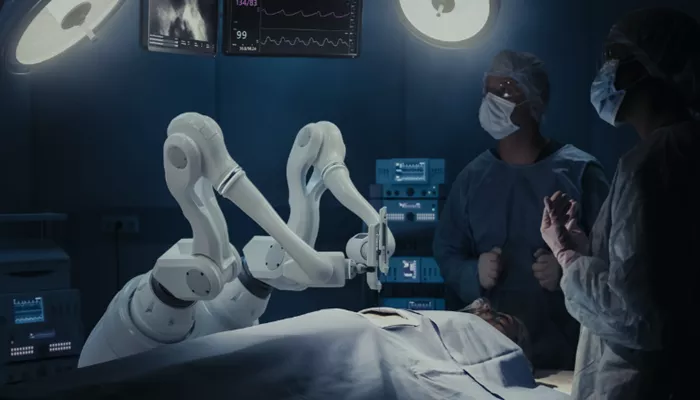Two surgeons at Rutgers New Jersey Medical School have become the first in the state to implement robotics in breast reconstruction following cancer treatment. The robot-assisted surgery offers a less invasive alternative to traditional methods, allowing patients to heal more quickly and experience smaller scars.
Edward Lee, a plastic surgeon, and Danbee Kim, a robotic surgery specialist, performed the groundbreaking procedure, marking a significant advancement in patient care. Their work could also signal the potential for robotic technology to revolutionize other forms of reconstructive surgery.
“This is just the beginning,” said Lee, who also leads the school’s plastic surgery residency program. “We’re exploring how robotics can be used for thigh muscle harvests, abdominal flaps, and other procedures. The potential to enhance outcomes across reconstructive surgeries is vast.”
The pair’s initial focus was on the latissimus dorsi flap reconstruction for breast cancer survivors, a procedure that involves removing muscles from the upper back to replace tissue lost during a mastectomy. Traditionally, this surgery requires a long incision across the back, leaving a significant scar and taking months to heal. However, the robotic technique allows for incisions made under the armpit, accessing the back muscle without disturbing the back itself, leading to faster recovery times and less visible scarring.
“The robot’s four arms—one for the camera and three for surgical tools—make the process significantly more precise,” said Kim. “It’s like having a third arm to assist, making the surgery easier and more efficient.”
This robotic system also reduces the need for additional surgical staff, who would traditionally be tasked with holding cameras and retractors. In turn, this could help reduce the overall cost of surgical procedures in the future. The robot’s high-definition camera further enhances the surgeons’ ability to identify tissue more clearly, enabling greater precision during the procedure.
Breast reconstruction, which is performed on more than 100,000 patients annually in the U.S. alone, is a key application for robotic surgery. The latissimus dorsi flap procedure is commonly used for those requiring radiotherapy after cancer treatment. Radiation can damage skin and tissue, so adding a layer of soft tissue helps protect the implant used in reconstruction.
Though the robot-assisted surgery initially took longer than traditional methods, Lee and Kim have seen their efficiency improve with practice. This mirrors a trend observed in other robotic surgeries, such as prostate and colon cancer procedures, where surgeons typically face a learning curve.
“We’re building on the groundbreaking work of international colleagues,” Kim said, who trained in South Korea. “Our goal is to refine this technique, expand its applications, and make it more widely accessible to patients.”
While robotic surgery was initially slow to gain traction—first introduced in the U.S. in 2000 but used in less than 1% of surgeries a decade later—its popularity has surged. Today, robotic surgery accounts for 22% of all surgeries performed in the U.S. As robotic technology continues to advance, it may soon play a significant role in replacing or supplementing human surgeons.
Moreover, the flexibility of robotic systems has the potential to enhance training for new surgeons. The robots feature dual consoles, allowing both experienced surgeons and their trainees to work on the same procedure in real time. This system can track and monitor the performance of both the instructor and the trainee, offering valuable insights into their progress.
“We track everything—from the time spent on each part of the surgery to the number of moves made by the surgeon and resident,” said Kim. “This allows us to gradually increase a trainee’s responsibilities and ensure we’re continually refining our techniques.”
While the benefits of robotic-assisted surgery are evident, questions remain about the long-term outcomes and cost-effectiveness of the technology. Lee and Kim are conducting ongoing research and plan to publish their findings to contribute to the growing body of evidence on robotic breast reconstruction.
“We’re meticulously tracking our outcomes and will publish a case series once we gather more data,” said Kim. “It’s essential that we demonstrate not only the feasibility of this approach but also its long-term benefits for patients.”
Despite the promise of robotic surgery, both surgeons stress that it may not be suitable for all patients. For certain procedures, such as those requiring the transfer of significant amounts of skin, the robotic method may offer limited advantages. As always, careful patient selection and detailed discussions about all available options remain central to the decision-making process.
“In the end, our goal is to provide the best possible outcomes for our patients,” Lee said. “If we can achieve that through smaller scars and faster recoveries, then we’ve succeeded.”
Related topic:
Yailin La Más Viral Undergoes Breast Implant Surgery, Explains Decision
CG Cosmetic Surgery and CG Smile Join Forces for Aesthetic Care


